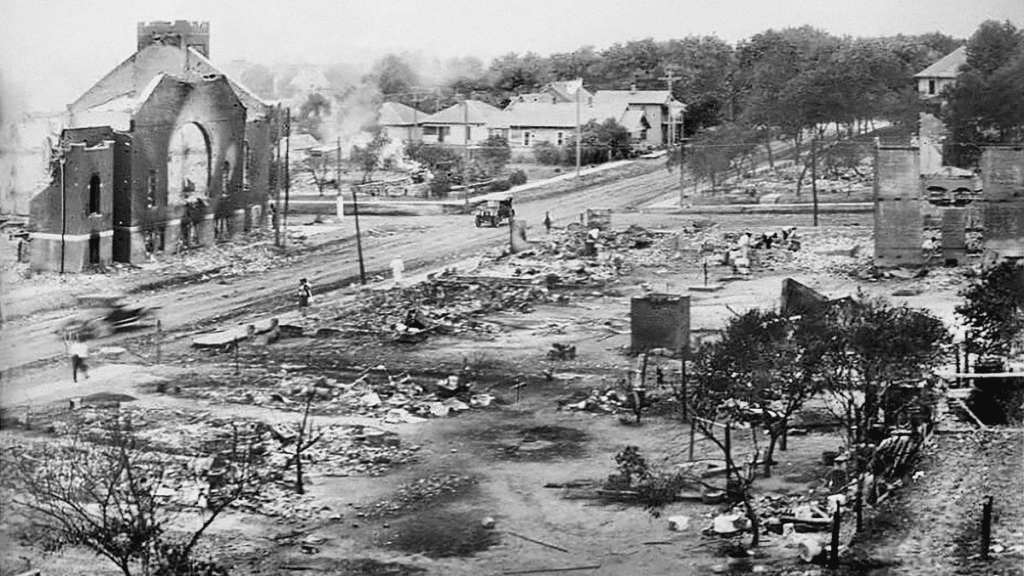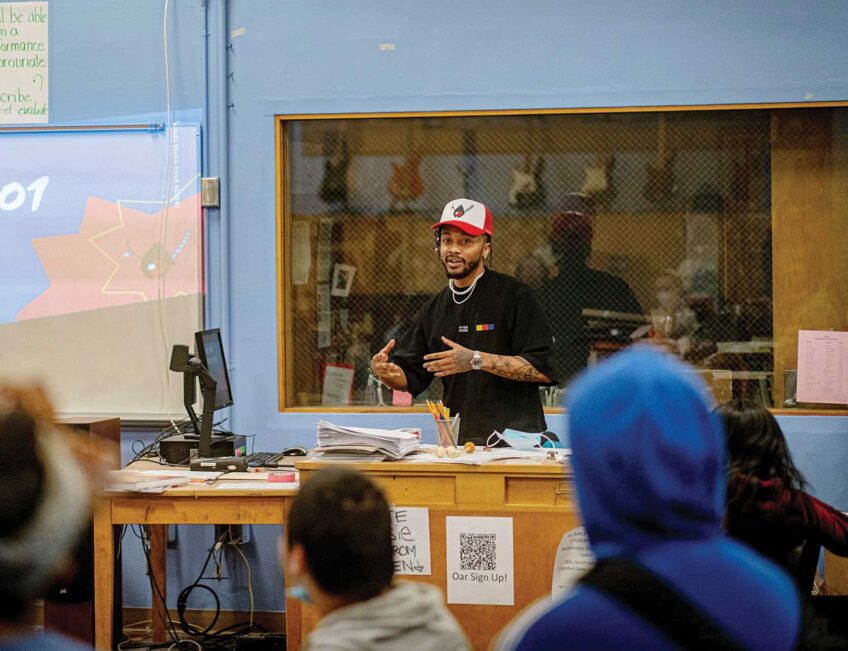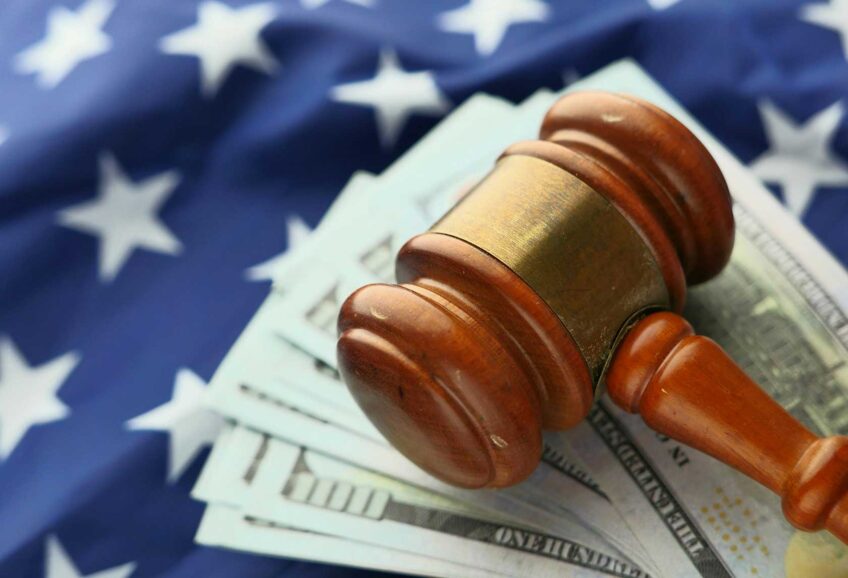Nation marks Tulsa massacre
Calls for reparations, recognition continue 100 years after incident

The horrific destruction of Tulsa’s “Black Wall Street” by a murderous white mob a century ago leveled 35 blocks of homes and businesses, displaced thousands, and left some 300 dead.
But the riot, sparked by a spurious accusation of sexual assault by a Black suspect, also left psychic scars that discouraged any talk of the violence for decades to come.
Recent attention on the massacre included a visit on Tuesday by President Joe Biden, Congressional hearings on reparations to the victims and their families, nationally covered commemoration ceremonies and a broader reckoning of the incident in the context of ways to narrow the racial wealth gap.
“For too long, the history of what took place here was told in silence,” said Biden to an audience that included centenarian survivors of the massacre. While darkness can hide much, it erases nothing.”
Citing harrowing vignettes of bodies being dragged through the streets, the corpses of murdered families draped over a fence and an elderly couple shot down while praying, Biden said, “We do ourselves no favors by pretending none of this ever happened. We should know the good, the bad, everything. That’s what great nations do: They come to terms with their dark sides.”
Coming to terms with violence that destroyed wealth, handicapping Black families for generations, was a constant theme of the weekend-long events marking the anniversary.
U.S. Rep. Sheila Jackson Lee (D-Tex.) said during ceremonies on Memorial Day that justice demands reparations for those killed in the violence, especially for Black veterans who fought for their country in World War I and then took up arms to defend their community in Tulsa.
“On this day, I’m going to utter the word reparations,” said Jackson Lee, quoted in the Washington Post, “because I do not believe it is inconsistent with the patriotic tradition of soldiers in arms, soldiers in cemeteries across America.”
In spite of the silence that long enfolded the massacre, public discussion of the events has spurred delayed debates about compensating victims – a reparations dialogue resonating with African Americans who believe a broader accounting for slavery should be part of the equation.
Carmen Fields, the well-known former Boston TV anchor, grew up in Tulsa, a mile north of the Greenwood District where torches and firebombs dropped from airplanes left hollow shells of once-thriving retail shops, billiard parlors, churches and homes on the night of May 31-June 1, 1921.
Conversations about the lives lost and the resistance put up by Black men, many of them armed veterans of World War I, were conducted in hushed tones, said Fields, who produced an award-winning 1993 documentary “Going Back to T-Town” that included many of the first recorded testimonies of survivors.
Her father’s older brother, living in nearby Sands Springs at the time of the massacre, was one of those former soldiers said to have been called to defend the accused assailant from being dragged out of the downtown courthouse and lynched. Clarence Fields, an expert marksman, never revealed whether he was among the men who exchanged gunfire in front of the building in a volley that left 10 white men dead before the ex-soldiers and their comrades fell back to defend Greenwood itself.
“I remember my brother telling me after a hunting trip with my uncle that he had heard the men talking about the incident. Someone asked my uncle, ‘How many did you kill, Clarence?’ and Clarence went ‘Shhhh…’ and pointed to my brother. It was not polite conversation in any company. Clarence never talked about it,” said Fields.
The Fields documentary helped shine light on the incident and marshal a sustained effort to account for the losses, hear from the victims and provide reparations.
Three years after the film’s debut and 75 years after the massacre, the Sooner State legislature created the Oklahoma Commission to Study the Tulsa Race Riot of 1921. The group’s final report, published in 2001, concluded that the City of Tulsa had conspired with the mob to destroy Greenwood – a prominent symbol of Black success – and recommended compensation to survivors and their descendants.
In 1997, Harvard Law Professor Charles Ogletree led an effort to sue the city and collect damages for survivors, citing the encouragement of the mob by Tulsa officials and their failure to prevent widespread looting, shooting and arson. That suit was dismissed.
A commemorative park was dedicated to the victims in 2010 and the incident became an official part of the Oklahoma school curriculum in 2020.
But rancor persists. The Tulsa mayor and Oklahoma governor both oppose reparations and disagreements within Tulsa’s Black community over using funds from commemorative events to compensate victims led to the cancellation of a concert featuring singing star John Legend and an appearance by former Georgia gubernatorial candidate Stacey Abrams.
“While we won’t be together tomorrow,” tweeted Legend on the commemoration eve, “I look forward to visiting with you in the near future, and, most importantly, to a true reckoning and reparations for the survivors and their descendants.”
A series of academic papers, including “The Destruction of Black Wall Street: Tulsa’s 1921 Riot and the Eradication of Accumulated Wealth,” published in 2018 in the American Journal of Economics and Sociology, document how much wealth disappeared with the flames that consumed the vibrant Greenwood community.
Researchers estimate a total direct property damage of $200 million in today’s dollars and link the vast losses to stifling Black innovation and wealth accumulation for hundreds of thousands of survivors and descendants.
Many Greenwood residents kept their cash at home over distrust of white-owned banks. White looters spirited away hard-won lucre as well as household valuables in a rampage that destroyed some 1,200 homes and left over 300 stripped and ransacked.
“From a 10-room and basement modern brick home, I am now living in what was my coal barn,” said C.L. Netherland, a prosperous Greenwood barber, who was quoted in a summary of the academic research in the Harvard Gazette weekly newspaper. “From a five-chair white enamel barber shop, four baths, electric clippers, electric fan, two lavatories and shampoo stands, four workmen, double marble shine stand, a porter and incomer of over $500 or $600 per month, to a razor, strop and folding chair on the sidewalk.”
Current tensions in Tulsa over reparations reflect a fraught history of race relations in Oklahoma that go back long before the first flames licked at the wood-frame and brick buildings of Greenwood.
After becoming a state in 1907, the first law passed by the legislature segregated all rail travel and banned Blacks from serving on local juries or holding local office. More recently, Oklahoma was the only state in the union where not one a single one of its counties backed Barack Obama in the 2008 and 2012 presidential election.
At the time of the Tulsa Massacre, memories were still fresh of the “Red Summer” of 1919, when riots, often touched off by police abuse, swept through close to 20 U.S. cities, with returning Black veterans defending their communities from surging white mobs. A young J. Edgar Hoover promoted a false communist conspiracy theory for the clashes, further inflaming fears and suspicions.
“Birth of a Nation,” the racist film first aired in 1915, was still wildly popular at the time of the massacre, and the Ku Klux Klan was growing in influence as a national party.
In Oklahoma, strict racial separation encouraged the development of Greenwood, with oil prosperity during the petroleum boom providing jobs and economic opportunity for Tulsa’s Black community. Named for the district established by Booker T. Washington in Tuskegee, Alabama, “the Negro Wall Street,” as it was soon called, was christened Greenwood in 1906, five years after Washington’s tour of Oklahoma.
The destruction of Greenwood was set in motion after the arrest on Memorial Day weekend of 19-year-old Dick Rowland for an alleged sexual assault on Sarah Page, 17, an elevator operator in a building often frequented by the shoeshiner. An inflammatory editorial, headlined “To Lynch Negro Tonight,” in the afternoon paper resulted in a crowd of whites forming outside the jail where he was being held.
A white man accused of murder had recently been lynched so concerns for Rowland’s safety were justified. About 60 Black men, armed with rifles and shotguns, appeared at the jail and confronted about 1,000 white men, some of whom peeled away to fetch their own weapons from home. Others attempted unsuccessfully to break into the nearby National Guard armory.
By evening, Rowland had been moved to the courthouse. The white mob had swelled by this time to over several thousand. According to witnesses, one of the white men told an armed Black man to surrender his pistol. In the ensuing exchange of words, a shot was fired. The resulting volley between the groups left 10 white men dead and felled two Blacks.
Gunfire continued as the Black men retreated into Greenwood. By 1 a.m., fires began appearing in the commercial district as Black families fled to safety. Crews from the Tulsa Fire Department were turned away at gunpoint. Rioters fired at families escaping the flames lit by torches and firebombs dropped by circling aircraft.
By morning, thousands of African Americans had been arrested or detained. The dead were quickly buried, covering up the extent of the slaughter. Recent excavations at local cemeteries have uncovered mass graves dating to the era.
W.E.B. DuBois, speaking the day after, said he knew why Greenwood had burned. “The colored people of Tulsa have accumulated property, have established stores and business organizations,” he said. Whites, he said, “feel their independent position and have boasted that in their community there have been no cases of lynching. With such a state of affairs, it took only a spark to start a dangerous fire.”
In spite of all the destruction and death, no arrests of whites were ever made and no charges ever filed. And the assault charge against Rowland was eventually dismissed.
The Greenwood District was rebuilt but never fully recovered. Urban renewal put a highway through its center in the 1960s. Greenwood’s commercial economy, never as robust as before the massacre, sagged even further.
Hanging like a haze over the distant memories is the fact that no one personally responsible for the shootings, arson and looting has ever come forward to atone for their complicity. Nor have their families.
“What is still outstanding in healing the wounds,” said Fields, “is that we don’t know the white citizens who wreaked this tragedy. And there can be no truth and reconciliation without the participation and reckoning of those who did harm.”






